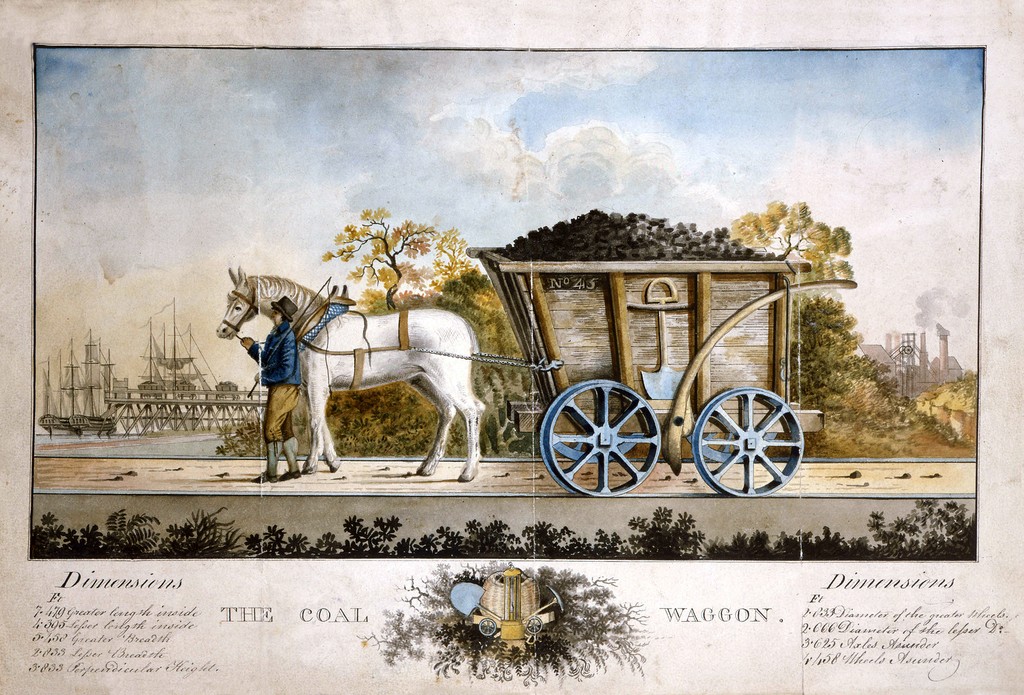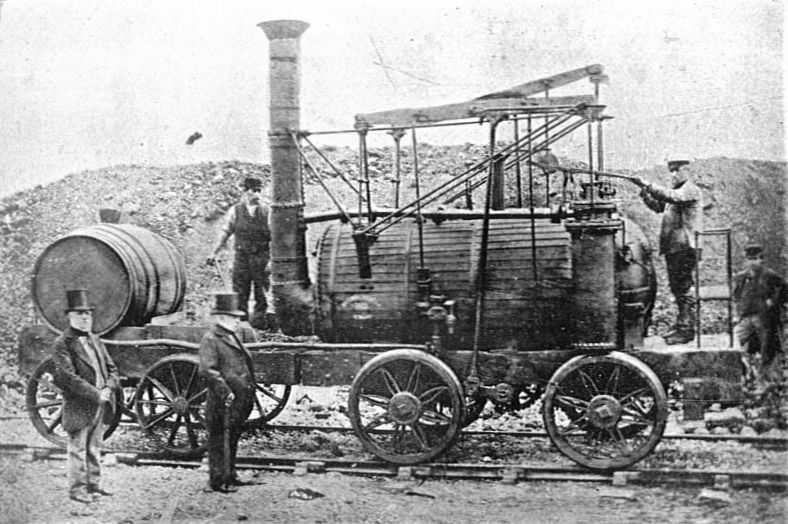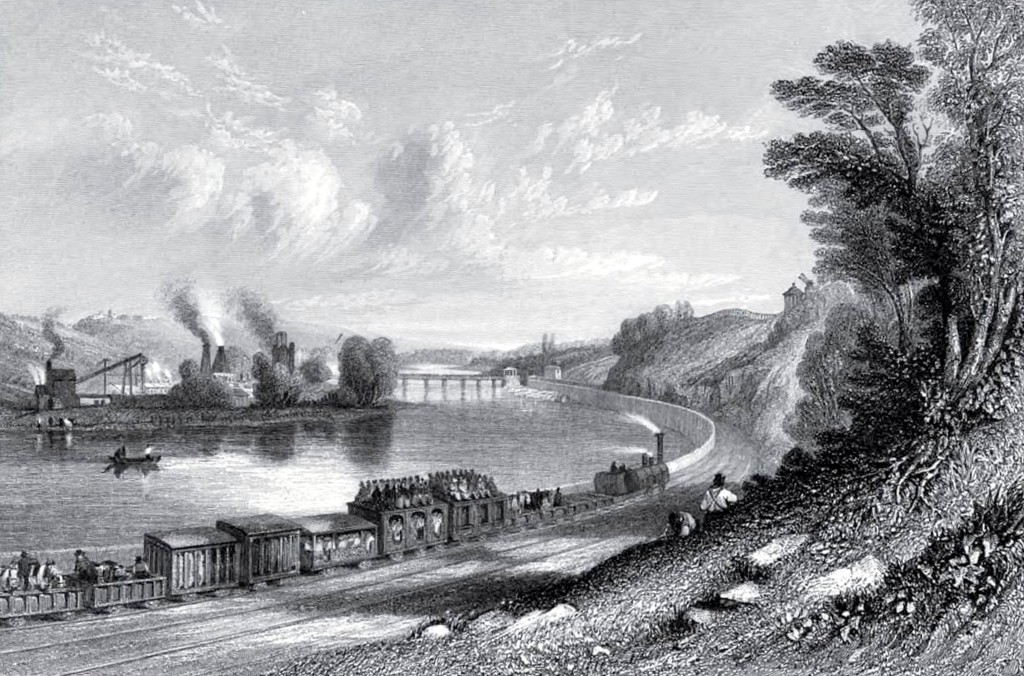It recounts memories of some 40 or 45 years earlier about certain Tyneside wooden waggonways and the early steam locomotives operating on the Wylam Waggonway.
The author is unnamed but clearly had a close connection and interest in the events taking place around him. It is possible that the newspaper is merely recycling an article previously published in a more local journal but if so I have yet to discover the original source.
While the great celebration of the jubilee of railway-opening is progressing this week at Darlington, it may be of interest to some to learn a little of what kind of railway a wooden one was. In jotting down a few reminiscences about the things under the heading of these lines, I shall not bind myself to anything like exact dates or strict technicalities, but shall jot them down as they arise to me from the memory of forty or forty-five years ago.
The first railway that I ever saw was a wooden one. The wooden rails would be on an average about nine or ten feet in length. They were, I believe, generally of beech and ash wood, and they were square in form. They were rough-hewn with an axe, and were fashioned by workmen who went by the name of "waggon-way wrights." These same "wrights" used also to lay them down. Where the wooden rails joined each other there was no socket or anything to form a close joint. The rough square ends were placed against each other, and this was the only joint or joining they had. The rails were laid upon sleepers, to which they were fastened by oak-pins driven through a bored hole into each other. The rails had frequently to be renewed, for the face upon which the waggon wheels ran splintered off in thin strips by the compression of the wheels. They were also frequently turned upside down, so that a new face was obtained. I do not think they broke much for they always lay on a bed of soft earth. There were "way-wrights," generally old men, whose sole occupation it was to keep "bedding or creasing the waggon-way." The waggons ran smoothly on these primitive rails, and with very little noise, save a creaking of the wood from the compression caused by the weight of the waggon laden with coals passing over it. The line that I refer to would be about three miles in length or perhaps more. During the greater part of its distance it was on an incline, at some places rather a steep one. Going down these inclines in wet or frosty weather was attended by many difficulties. The waggons had cast metal wheels with brakes made mostly of birch wood. There was no iron about the brakes except the nails which fastened its pieces together. I have sometimes seen waggons run away on wet or frosty days with a "prop" as a spoke in each wheel. The speed of the run-away used generally to bring the waggon to grief at the first turn it came to; for "off the way" it would fly, sometimes completely turning upside down. The waggons were what would now be called great lumbersome things. They carried three tons of coals each, and were made nearly all of wood; the sides and stays of them thick, rough, and clumsy. One horse used generally to draw two waggons on the line I refer to, and considering that these two waggons contained six tons of coals, the wooden rails for them to pass over were a great improvement upon mere cart roads. The line was most of its way a single one, though at intervals there where sidings for the "team waggons" to pass on to, in order to allow the laden ones to pass. I well remember certain places on the line where the horses used to be stopped to take "a blaw." The "waggon-way-men," for such was the technical name for the horse-drivers, during the "blaw" used to produce a steel pocket-knife, a piece of flint, a small pocket tinder-box, and a brimstone match, the combined uses, of which produced a conflagration great enough "to leet a bit o' backy in a cutty pipe." These "waggon-waymen" took great pride in their horses and even in the waggons, if the latter were easy, good "ganners," (i.e. runners). There were two coal pits, at the time of which I write, whose produce passed over the wooden waggon-way. The one at about three miles distance from the river Tyne was named "The Folly Pit," and the other at half the distance was called "Stargate Pit" - they both belonged to George Dunn, Esq. of Bath-house, Newcastle-on- Tyne. The old wooden line passed down for a good part of its length in an interstice between hills running parallel pretty nearly with each other. The Stargate hills were covered at that time by a forest of whins, broom, and ferns as big as trees in their trunks. These hills were the abode of vast numbers of foxes; and herds of donkeys used to make them their rendezvous. They ran in form somewhat wave shaped - and in Spring-time the yellow flowers of the whins and broom seemed to form a yellow or golden sea which looked exceedingly pretty. At this season of the year they now form yellow fields of corn. At the time of which I write, in the spring and summer, and indeed most of the year, Stargate Hills were a kind of paradise for birds of the finch tribe. And hither pitmen would repair with their "bird-limed wands," and their decoy. Fancy cages these pitmen used to make for their birds were many of them highly ingenious and beautifully finished specimens of the cage-maker's art. The pit-men of those days always had a hobby; and in carrying it out there was generally very great ingenuity of almost every man turning his attention to ingenious contrivances that at last culminated in the invention of the steam-engine by one of themselves, of whose genius oratorical accounts will keep the next few days. After passing the Stargate hills, the wooden waggon-way passed along the Stella bogs, abode of the Heliades on account of the many large and beautiful alder trees that flourished in them. "Path-head" woods were next passed through, wherein stood the famed "Violet Spout," out of which came water, even in a Tyneside keelman's opinion, that was better for drink than was "Shields yel." At Stella-on-Tyne stood the staith for the reception of the coals which came from the collieries named above, and from which these coals were taken down the Tyne in keels to ships lying in harbour, then chiefly at Shields.
Now, looking backwards for nearly half a century at that old wooden waggon-way; at the lumbersome looking waggon passing over it, with the "mouth-poke" containing corn, and the sack filled with hay for the refreshment of the horse, and the grease-pot with a stick in it for the purpose of greasing the waggons, and the tin coffee bottle, the tin dinner box and the wallet of the "waggon-way-man" all hung around it; at the old women and children upon the same waggon-way gathering coals, any quantity of which might be picked up and taken away without a word being said; at the fine fat, sleek looking horses; at the "waggon-way-man" clad in strong, rough flannel jacket, vest and knee breaches, and as he passes along trolling out some old fashioned song - and I have a picture before my mind's eye that has passed away most likely forever.
"If thou'll take as much drink every day as we do and do our work, thou'lt find it all blown off at night."
The Billy often "broke down" as a mishap was technically called. At such times - on whatever part of the road it was, a man had to be dispatched to Wylam to acquaint the engineers. The chief of these was Mr. Jonathan Robson who had for his co-adjutor Mr. Kircup. One or other, or both, of these gentlemen, with two or three assistants would, on learning the nature of what had befell the Billy, start off in a little waggon, called the ballast waggon, drawn by a horse, to repair the disaster. The two engineers named were friends of George Stephenson, and many a good anecdote I have heard them and my relative relate of the great engineer. After the opening of the Stockton and Darlington line, my relative met Mr. Stephenson one day in Newcastle and said to him,
"Well, Geordie, I suppose if you could get all the folks of Newcastle into railway carriages such as you have at Stockton, your new engines could pull them along?"
Mr. Stephenson replied,
"Jimmy, hinney, wor new engine is like fifty draught horses to a cuddy (donkey) compared with either of your puffing Dillies."
My relative had become acquainted with George Stephenson when the latter lived in a house on the Wylam waggon-way. There was a pitman at Wylam at the time l am writing of - lsaac Jackson, I believe he was named. This man could neither read nor write, I believe, but was a wonderful mechanist, and also mathematician, curious to say. I remember once being at a raffle for a timepiece be had made. The workmanship was of extreme beauty, and the clock not only denoted the hour of the day but many other mathematical and astronomical particulars:- such as the time of day at all the chief capitals of the world - the latitude and longitude of these - the position of the planets - the sun's height and declination at a given time - and many things which I forget. I believe the invention of the steam whistle is owing to a blacksmith, who at that time lived at Wylam. The Billy was certainly a great improvement upon the horse for drawing coals in large quantities along dead levels, or, in short, over any ground or distance - but it was a miserable mode of locomotion compared with the splendid locomotive engines of the present-day. It was a very amusing spectacle to see the Billy on its travels on a frosty morning. Its snorting and wheezing and accelerated motion of the bobbing up and down of its piston cranks - all ineffectual - for it was not making scarcely any head-way. At one part of the Wylam line there was a curve upon which the Billy - bad weather or good - always had to make a gradual retardando movement until at last it came to a dead stop, and then a pause had to be made till steam got up again. Often the water in its cistern would get all used, and the drivers in such case had to repair to the Tyne, to which the Wylam waggon-way ran almost parallel for most of its length, with buckets to replenish their supply. To perform its necessary duties in winter time, in bad weather, the Dilly often had to be on the road from four or five in the morning to seven, eight, and even nine at night. It used to be said, if I remember rightly, that the Wylam Billy owed its origin to a man that used to be called "Billy Hedley." I do not know that I knew more of him than that he was viewer or colliery agent for Mr. Blackett. I suppose the history of the Wylam dillies has been written, but I have never seen one.





 RSS Feed
RSS Feed
